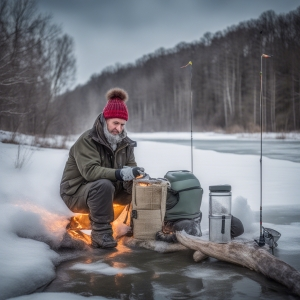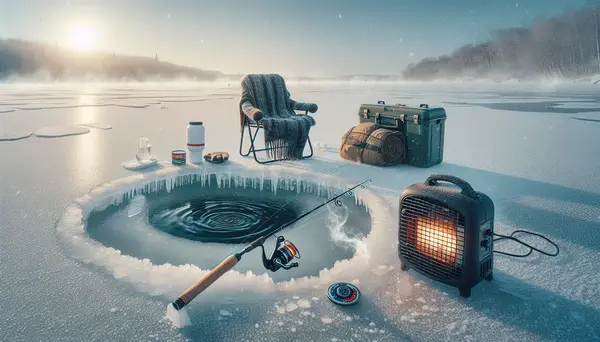Table of Contents:
Introduction: Embarking on an Ice Fishing Adventure
Are you ready to brave the cold and embark on an exhilarating ice fishing adventure? Given the unique challenges it presents, ice fishing can be a thrilling experience providing both excitement and satisfaction. However, being out on a freezing lake requires more than just courage – it demands careful preparation. From staying warm in sub-zero temperatures to catching big fish in seemingly unfriendly environments, ice fishing is a skill that needs mastering. In this guide, we will share essential tips and gear you need to stay warm and catch big fish in cold conditions. So whether you are a seasoned angler seeking to round out your fishing skills or an outdoor enthusiast looking for a novel winter adventure, this article will provide valuable insights to enhance your ice fishing experience.
Understanding Ice Fishing: What It Really Is
Ice fishing, on the surface, may seem straightforward - cutting a hole in the ice and waiting for the fish to bite. However, the reality of the sport involves much more than that. Suited to brave anglers, it's the ultimate test of patience, precision, and grit. You're not just angling in cold conditions; you're targeting fish in an environment that changes continually, demanding unique tactics and a fresh approach. In this section, we delve deeper into the intriguing activity that is ice fishing, explaining its essentials and how it poses a challenge different from your standard fishing experience.
Pros and Cons of Ice Fishing Essentials for Staying Warm and Catching Big Fish
| Pros | Cons |
|---|---|
| Thermal clothing can keep the angler warm for extended periods. | Thermal clothing can be bulky and restrict movement. |
| High tech fishing equipment increases the chances of catching big fish. | Advanced fishing gear can be expensive and complicated to use. |
| Portable heaters can provide immediate warmth in freezing conditions. | Portable heaters can pose safety risks and require fuel or electricity. |
| Fishing shelters provide protection from the elements. | Fishing shelters can be heavy to transport and time-consuming to set up. |
| Wireless sonars can identify fish under the ice. | Wireless sonars rely on batteries and can glitch in extreme cold. |
Essential 1: Choosing the Right Gear to Stay Warm

The fundamental aspect of ice fishing is, of course, staying warm. Exposing yourself to plummeting temperatures without the right gear can be perilous. So, the key is to invest in quality gear designed for cold-weather use. Your clothing should be conspicuously bright for visibility, waterproof, and highly insulating.
Start with a good set of thermal underwear and layer it with a fleece or wool mid-layer for added warmth. Ensure your outer layer is windproof and waterproof to prevent chilly winds and moisture from penetrating through. A quality pair of winter boots with thick socks should protect your feet from the cold floor. Lastly, protect your head, hands, and neck with a balaclava, gloves, and a scarf.
Besides clothing, some other gear such as a thermal flask for hot drinks, a heating pad, blankets, and hand warmers can keep you comfortable during your ice fishing endeavor. Remember, preparation is key, and layering is critical when ice fishing.
Essential 2: Selecting the Right Ice Fishing Tools
Along with right layering for warmth, the correct fishing tools can make a significant difference in your fishing experience. The list isn't lengthy, but each piece of equipment plays a crucial role.
The primary piece of your kit should be an ice auger. This tool is designed to bore holes into the thick ice, providing access to the fish beneath. They come in manual and powered versions, and the choice largely depends on personal preference and the thickness of the ice you plan to tackle.
Next, you will require a quality ice fishing rod. These rods are shorter and typically more sensitive than regular fishing rods, designed to detect subtle bites in the frigid water. Use a tip-up to signal when a fish bites - it's a small flag that pops up when a fish takes the bait, allowing you to monitor multiple lines at once.
Ice fishing lures and baits are also vital. Remember that fish behave differently in cold water so using lures designed specifically for ice fishing can achieve better results. Vary the bait and adjust your strategy based on what species you are targeting.
Lastly, don't forget your fishing line! The cold environment can be tough on fishing lines, making them brittle. It is advisable to use a line specially designed for ice fishing, which can withstand freezing temperatures.
By picking the right tools designed for ice fishing, you improve your chance of success while making the experience more enjoyable.
Essential 3: Focus on Safety Measures

Safety should be your prime focus when heading out for an ice fishing adventure. From testing the ice to carrying tools for self-rescue, taking safety measures enhances your confidence and ensures you enjoy the activity without threat.
Firstly, never assume that the ice conditions are safe. Even if it looks thick, always check for the thickness and consistency of ice before stepping on it. A good rule of thumb is that ice should be at least 4 inches thick for you to walk on it.
Another measure is to never to go fishing alone. Having a fishing buddy allows you to look out for each other. Plus, carrying a whistle or some form of noise-making device can alert others in case of an emergency.
Always have self-rescue tools on hand when ice fishing. Ice picks or claws can help you crawl back onto the surface if, unfortunately, you fall through the ice. Wear life jackets or float suits under your regular winter clothing for an added layer of safety.
Bring along a well-stocked first-aid kit for any minor injuries that could occur. Having items such as bandages, antiseptic wipes, and gauze can be a lifesaver. Also, keep emergency contact numbers accessible and make sure your mobile phone is fully charged.
Mindful actions, awareness, and planning can make your ice fishing trip safe and memorable!
Essential 4: Tips for Catching Big Fish in Cold Conditions
One of the core attractions of ice fishing is the opportunity to catch big fish. Cold-water species like Walleye, Northern Pike, and Trout become more active in winter, elevating the chances of landing a big one. However, destination planning, correct bait usage, and understanding fish behavior under the ice are vital.
Scout the area and look for fishing hotspots like weedbeds, submerged structures, and drop-offs that attract fish. Remember, GPS and fish finders can be a tremendous help in finding these sweet spots. Depth and water temperature also play a role in where fish gather in a lake or pond.
You should know how to make your bait more appealing in cold water. Lively presentations often get the best attention from fish in sub-zero environments. Using specific ice fishing lures that simulate prey movement can attract fish effectively. Jigging a spoon near the bottom or incorporating subtle movements can make a significant difference in your catch rate.
Learn about the patterns and habits of the fish you target. For instance, Walleye tends to feed in low-light conditions, meaning dawn and dusk may present the best opportunities. Meanwhile, species like Perch can often be found in schools, so catching one likely indicates more in the vicinity. Each species has different preferences in temperature, feeding times, and habitats.
In conclusion, to catch big fish in cold conditions, you need a combination of right gear, understanding of fish behavior in winter, and patience. And remember, practice makes perfect; the more you ice fish, the better you'll get at it.
Final Thoughts: Thriving in The Art of Ice Fishing

Ice fishing is indeed an art thriving in a beautifully unique yet harsh environment that tests not just your fishing skills, but your perseverance as well. From battling biting cold winds to patiently waiting for a bite beneath the ice, it's an adventure that can bring an amazing sense of fulfillment.
Investing time in properly preparing, getting the right gear and mastering the technique will enable you to have a safer, and overall more enjoyable ice fishing experience. With today's advancements in gear and technology, ice fishing has become more accessible than ever, giving you the opportunity to revel in the thrill and delight of this winter activity.
Ultimately, bear in mind that it's not just about the fish you reel in, but the entire journey that gets you there - the brisk cold air, the serene frozen landscapes, and of course, the captivating thrill of the catch. So, gear up, stay safe, and enjoy the beauty of ice fishing.
Ice Fishing: Staying Cozy and Landing Big Catch in Frosty Situations
What are the necessary items for ice fishing?
The essential items include a strong fishing rod, proper fishing line for cold weather, bait, an ice auger to drill holes, warm clothing, a portable heater, and a comfortable chair.
How can I stay warm while ice fishing?
Dressing in layers, using hand and foot warmers, bringing a portable heater, and drinking warm beverages can help you stay warm while ice fishing.
What kind of fish can I catch when ice fishing?
The type of fish you can catch depends on the area, but common types include Walleye, Northern Pike, Perch, and Trout.
How can I attract big fish while ice fishing?
Using the right bait and understanding fish behavior, including feeding times and preferred locations, can help attract big fish while ice fishing.
Is ice fishing safe?
Ice fishing can be safe if appropriate precautions are taken. This includes verifying the ice thickness for safety, dressing appropriately for the weather, and not fishing alone.







